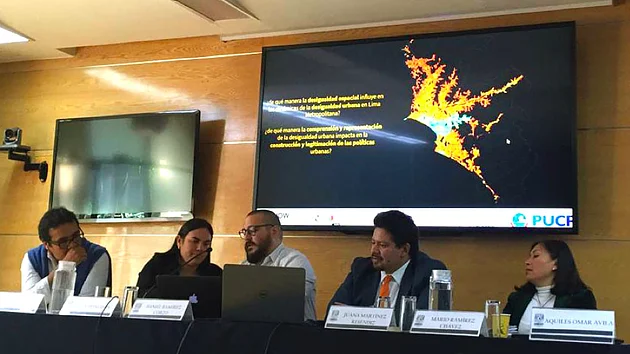Reframing indicators and cartographic representations to render visible everyday experiences of urban inequalities in Lima
 KNOW City Partners Belén Desmaison and Daniel Ramirez Corzo, presenting at the “Territorial transformations and inequalities” panel. Image by Manuel Dammert.
KNOW City Partners Belén Desmaison and Daniel Ramirez Corzo, presenting at the “Territorial transformations and inequalities” panel. Image by Manuel Dammert.October 2019 was an agitated month in the Latin American region, with protests arising in Ecuador, Peru, Bolivia and, most notably, in Chile, where manifestations continue in a general outcry against the country’s perceived inequalities and a demand for structural changes to the governance system. In this context, the International Seminar “Urban inequalities - The right to the city and local governance in Latin American Cities” took place at the Universidad Autónoma de México in México City from 23rd – 25th October. The seminar’s inaugurating panel opened the event by expressing the urgent necessity for Latin American countries to promote solutions to reduce inequalities.

The three-day event consisted of over 50 presentations and brought together urban scholars, practitioners, and activists from across Latin America. KNOW Lima City Partners Belén Desmaison and Daniel Ramírez Corzo contributed with a presentation called “Spatial and urban inequality in Metropolitan Lima: a view from the collaborative reading of the territory and urban policies.
KNOW City Partners Belén Desmaison and Daniel Ramirez Corzo, presenting at the “Territorial transformations and inequalities” panel. Image by Manuel Dammert.
Their presentation investigated the relation between urban inequality as a whole, and complex systems and spatial inequalities in particular, understanding the territory as a subsystem that manifests and reproduces relations of inequality. Additionally, the presentation explored how these relations are understood and portrayed by traditional urban indicators and metrics, and how oversimplified representations of such a complex phenomenon help to sustain and legitimise urban policies that do not address urban inequalities.
The presentation revised the latest census statistics, which are the only official data available to approach the geographical distribution of urban poverty and inequality within the city. However, this data is based upon the “household” (for social indicators) and “dwelling” (for physical indicators) as their departing units. This way of building and representing data, while effective for general and abstract overviews, leaves out most of the spatial realities and daily experiences of the women and men within these households and their differentiated access to quality public spaces, accessible and convenient public transport, public services, and just livelihoods.
Maps produced by KNOW-Lima depicting census data at the district level. They show how data renders invisible inequalities experienced within each district, falsely portraying a homogeneous reality at the district level.
As part of the KNOW programme, the Lima City team explored other approaches to reveal and represent spatial inequality. One of them, developed in collaboration with students from PUCP’s Faculty of Architecture and Urbanism (FAU-PUCP), was to investigate a cross-section of the metropolitan area, which spans across wealthy areas as well as different vulnerable neighbourhoods. The analysis of this area was informed by third-party information and fieldwork. It helped to highlight and understand the deep inequalities concerning not only the residential dimension of urban inequality, but that of a multiplicity of urban systems as well. Additionally, this activity sought to shed light on how cartography and architectural representations of the territory can render invisible daily experiences of inequality, as well as social mobilisation efforts that seek to challenge it, as the ones produced by NGOs like CIDAP, CENCA, and Foro Ciudades para la Vida. This invisibility legitimises political discourses that emphasize the material manifestations of inequalities while failing to address the structural factors that cause them.









